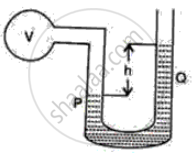Advertisements
Advertisements
प्रश्न
What should be the ratio of area of cross section of the master cylinder and wheel cylinder of a hydraulic brake so that a force of 15 N can be obtained at each of its brake shoe by exerting a force of 0.5 N on the pedal ?
उत्तर
Let the ratio of area of cross - section of the master cylinder and wheel cylinder be A1 : A2
Force on pedal , F1 = 0.5 N
Force on break shoe , F2 = 15 N
By the principle of hydraulic machine,
Pressure on narrow piston = pressure on wider piston
or , `F_1/A_1 = F_2/A_2`
or , `F_1/F_2 = A_1/A_2`
or , `A_1/A_2 = 0.5/15`
or , `A_1/A_2 = 1/30`
Thus , the required ratio is 1:30
APPEARS IN
संबंधित प्रश्न
A force of 50 kgf is applied to the smaller piston of a hydraulic machine. Neglecting friction, find the force exerted on the large piston, if the diameters of the pistons are 5 cm and 25 cm respectively.
The area of cross-sections of the pump plunger and press plunger of a hydraulic press is 0.02 m2 and 8 m2 respectively. If the hydraulic press overcomes a load of 800 kgf, calculate the force acting on the pump plunger.
Select the correct option.
One Pascal is equal to
Select the correct option.
The pressure exerted by 50 kg (g = 10 m/s−2) on an area of cross-section of 2 m2 is
At a given place, a barometer records 70 cm of Hg. If the mercury in the barometer is replaced by water, what would be resulting in reading? (Density of Hg = 13600 kg/m3; Density of water = 1000 kg/m3)
P is the pressure at some point in a liquid. State whether pressure P is a scalar or vector quantity.
The following figure shows a manometer containing a liquid of density p. The limb P of the manometer is connected to a vessel V and the limb Q is open to atmosphere. The difference in the levels of liquid in the two limbs of the manometer is h as shown in the diagram. The atmospheric pressure is P0.
(i) What is the pressure on the liquid surface in the limb Q?
(ii) What is the pressure on the liquid surface in the limb P?

State and explain Pascal's law of transmission of pressure.
Hydraulic lift works under the principle of _______.
Match the following:
| 1. | Hydraulic press | a. | Archimedes |
| 2. | Cartesian Diver | b. | Floatation |
| 3. | Hydrostatic Balance | c. | Pascal’s law |
| 4. | Hydrometer | d. | Buoyancy |
